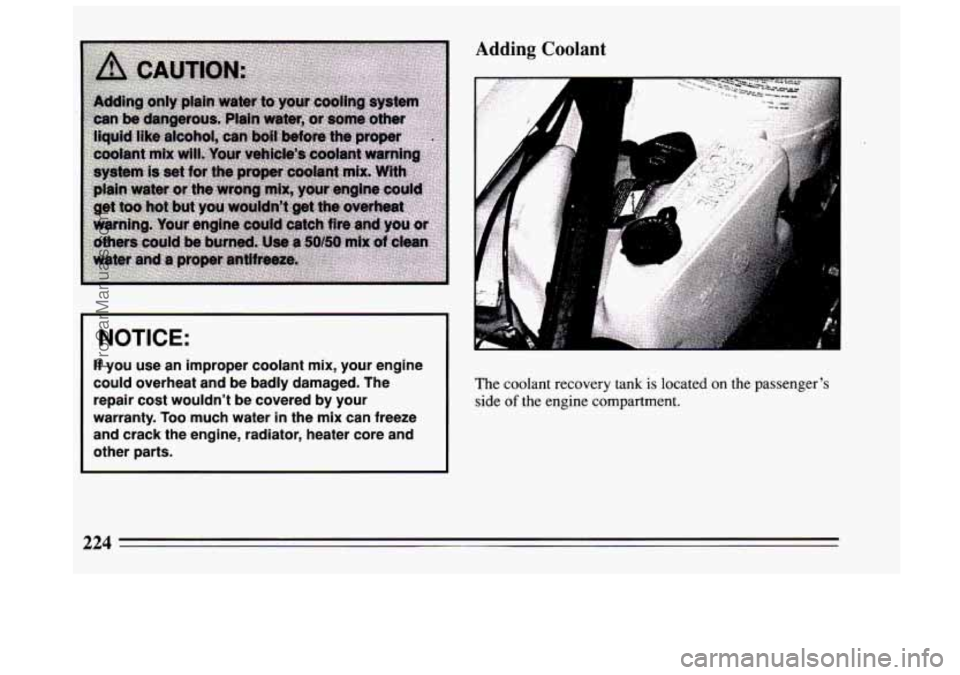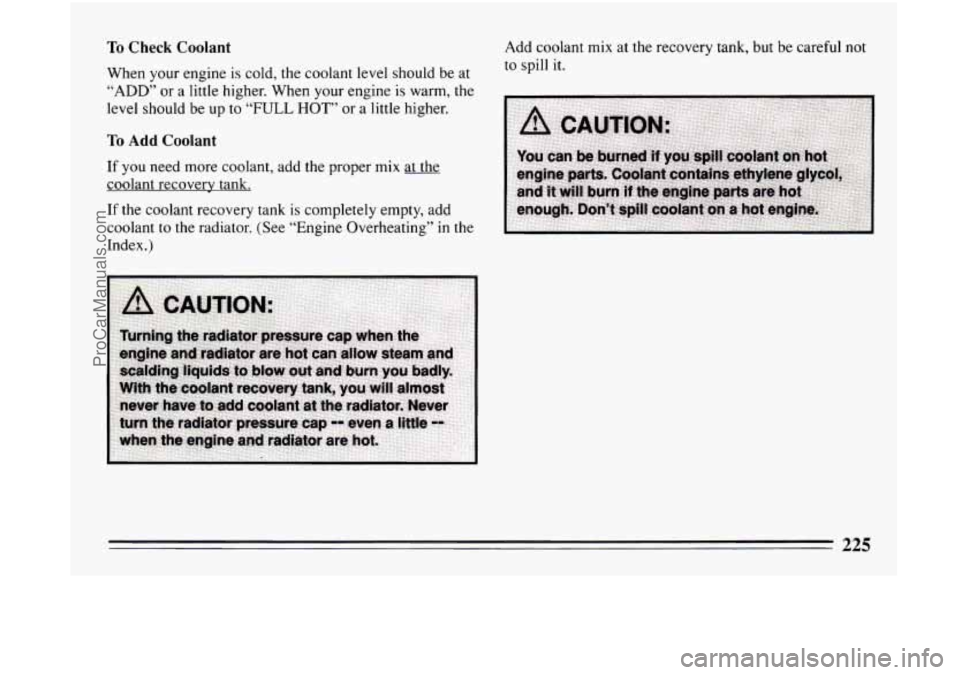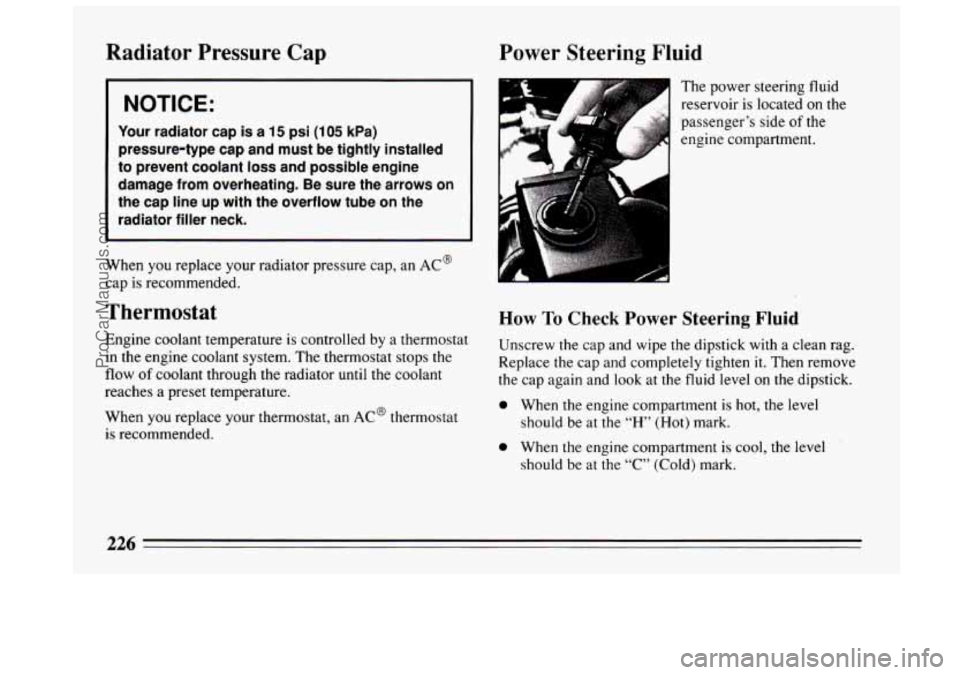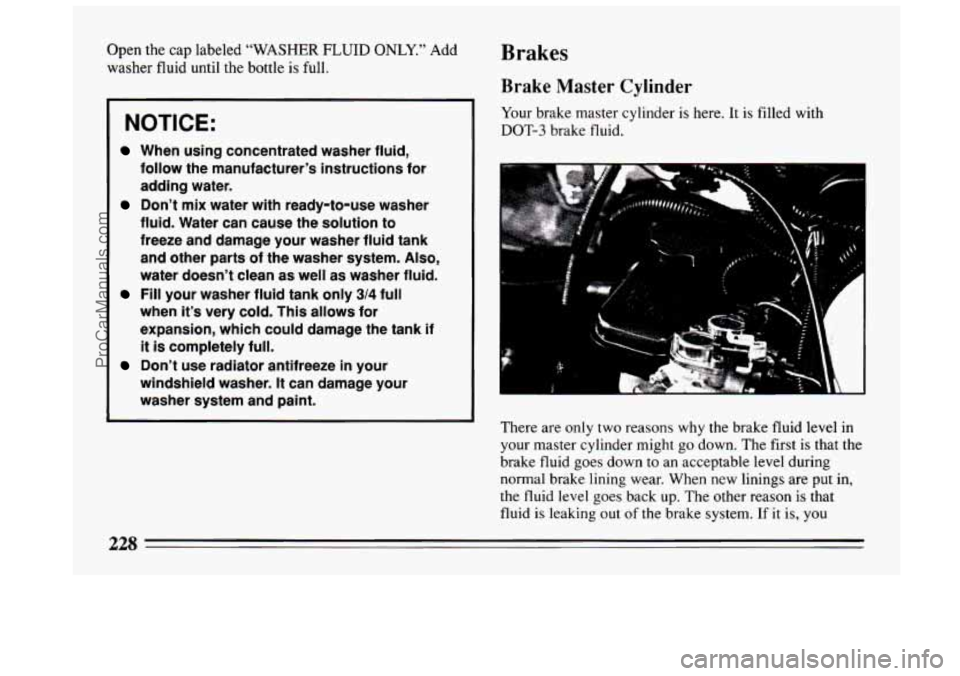1994 BUICK CENTURY radiator
[x] Cancel search: radiatorPage 194 of 308

7. Put the cap back on the coolant recovery tank, but
leave the radiator pressure cap off.
8. Start the engine and let it run until you can feel the
upper radiator hose getting hot. Watch out for the
engine fan.
9. By this time the coolant level inside the radiator
filler neck may be lower. If the level is lower, add
more of the proper
mix through the filler neck until
the level reaches the base of the filler neck.
192
ProCarManuals.com
Page 225 of 308

How to Add Fluid
Refer to the Maintenance Schedule to determine what
kind of transaxle fluid
to use. See “Recommended
Fluids and Lubricants” in the Index.
Engine Coolant
If the fluid level is low, add only enough of the proper
fluid to bring the level into the cross-hatched area on the
dipstick.
1. Pull
out the dipstick.
2. Using a long-neck funnel, add enough fluid at the
It doesn’t take much fluid, generally less than a pint
(OSL).
Don’t overfill. We recommend you use only
fluid labeled DEXRON@-I11 or DEXRON@-IIE,
because fluids with that label are made especially for
your automatic transaxle. Damage caused by fluid other
than DEXRON@-I11 or DEXRON@-IIE is
not covered
by your new vehicle warranty. dipstick
hole
to bring it to the proper level.
After adding fluid, recheck the fluid level as
described under “How to Check.”
0 When the correct fluid level is obtained, push the
dipstick back in all the way. The following explains
your cooling system and how to
add coolant when it is low. If you have a problem with
engine overheating or if
you need to add coolant to your
radiator, see “Engine Overheating” in the Index.
The proper coolant for your Buick will:
0 Give freezing protection down to -34°F (-37°C).
0 Give boiling protection up to 262 “F ( 128 “C).
0 Protect against rust and corrosion.
Help keep the proper engine temperature.
0 Let the warning lights work as they should.
What to Use
Use a mixture of one-half clean water (preferably
distilled) and one-half antifreeze that meets “GM
Specification 1825-M,” which won’t damage aluminum
parts.
You can also use a recycled coolant conforming to
GM Specification 1825-M with a complete coolant flush
and refill. If you use this mixture,
you don’t need to add
anything else.
223
ProCarManuals.com
Page 226 of 308

Adding Coolant
NOTICE:
If you use an improper coolant mix, your engine
could overheat and be badly damaged. The
repair cost wouldn’t be covered by your
warranty.
Too much water in the mix can freeze
and crack the engine, radiator, heater core and
other parts.
The coolant recovery tank is located on the passenger’s
side
of the engine compartment.
224
ProCarManuals.com
Page 227 of 308

To Check Coolant
When your engine is cold, the coolant level should be at
“ADD” or a little higher. When your engine is warm, the
level should be up to
“FULL HOT’’ or a little higher.
To Add Coolant
If you need more coolant, add the proper mix at the
coolant recovery tank.
If the coolant recovery tank is completely empty, add
coolant to the radiator. (See “Engine Overheating” in the
Index.) Add
coolant mix at the recovery tank, but be careful not
to spill it.
225
ProCarManuals.com
Page 228 of 308

Radiator Pressure Cap
I NOTICE:
Your radiator cap is a 15 psi (105 kPa)
pressure-type cap and must be tightly installed
to prevent coolant
loss and possible engine
damage from overheating. Be sure the arrows on
the cap line up with the overflow tube on the radiator filler neck.
When you replace your radiator pressure cap, an AC@
cap is recommended.
Thermostat
Engine coolant temperature is controlled by a thermostat
in the engine coolant system. The thermostat stops the
flow
of coolant through the radiator until the coolant
reaches a preset temperature.
When
you replace your thermostat, an AC@ thermostat
is recommended.
Power Steering Fluid
The power steering fluid
reservoir
is located on the
passenger’s side
of the
engine compartment.
How To Check Power Steering Fluid
Unscrew the cap and wipe the dipstick with a clean rag.
Replace the cap and completely tighten it. Then remove
the cap again and look at the fluid level
on the dipstick.
0 When the engine compartment is hot, the level
should be at the
“H” (Hot) mark.
0 When the engine compartment is cool, the level
should be at the “C” (Cold) mark.
ProCarManuals.com
Page 230 of 308

Open the cap labeled “WASHER FLUID ONLY.” Add
washer fluid until the bottle is full.
NOTICE:
When using concentrated washer fluid,
follow the manufacturer’s instructions for
adding water.
Don’t mix water with ready-to-use washer
fluid. Water can cause the solution to
freeze and damage your washer fluid tank
and other parts of the washer system.
Also,
water doesn’t clean as well as washer fluid.
Fill your washer fluid tank only 3/4 full
when it’s very
cold. This allows for
expansion, which could damage the tank if
it is completely full.
windshield washer.
It can damage your
washer system and paint.
Don’t use radiator antifreeze in your
Brakes
Brake Master Cylinder
Your brake master cylinder is here. It is filled with
DOT-3 brake fluid.
There are only two reasons why the brake fluid level in
your master cylinder might go down. The first is
that the
brake fluid
goes down to an acceptable level during
normal brake lining wear. When new linings are put in,
the fluid level goes back up. The other reason is that
fluid
is leaking out of the brake system. If it is, you
228
ProCarManuals.com
Page 272 of 308

Explanation of Scheduled Maintenance
Services
Below are explanations of the services listed in Schedule
I and Schedule
11.
The proper fluids and lubricants to use are listed in
Section D. Make sure whoever services your vehicle uses
these. All parts should
be replaced and all necessary
repairs done before you or anyone else drives the vehicle.
NOTE: To determine your engine’s displacement and
code, see “Engine Identification” in the Index.
1. Engine Oil and Filter Change* -- Always use SH
or SG Energy Conserving I1 oils of proper viscosity.
The
“SH or SG’ designation may be shown alone or
in combination with others, such as “SH/CD’ or
“SH, SG, CD,” “SG/CD,”etc. To determine the
preferred viscosity for your vehicle’s engine (e.g.,
SAE 5W-30 or SAE 10W-30), see “Engine Oil” in
the Index.
2. Chassis Lubrication -- Lubricate the transaxle shift
linkage, parking brake cable guides, underbody
contact points and linkage. If your vehicle is equipped with grease fittings, lubricate the suspension and steering linkage. 3.
Tire and Wheel Rotation and Inspection -- For
proper wear and maximum tire life, rotate your tires
following the instructions in this manual. See “Tires,
Inspection
& Rotation” in the Index. Check the tires
for uneven wear or damage. If you see irregular or
premature wear, check the wheel alignment. Check
for damaged wheels also.
4. Engine Accessory Drive Belt(s) Inspection --
Inspect the belt(s) for cracks, fraying, wear and
proper tension. Replace as needed.
5. Cooling System Service* -- Drain, flush and refill
the system with new or approved recycled coolant
conforming to GM Specification 1825M. Keep coolant
at the proper mixture as specified.
See “Coolant” in the
Index.
This provides proper freeze protection and boil
protection, corrosion inhibitor level and maintain
proper engine operating temperature.
Inspect hoses and replace if they are cracked,
swollen or deteriorated. Tighten screw type hose
clamps. Clean the outside of the radiator and air
conditioning condenser. Wash the pressure cap and
neck
To help ensure proper operation, we recommend a
pressure test
of both the cooling system and the
pressure cap.
270
ProCarManuals.com
Page 298 of 308

Methanol in Gasoline ............................. 209
Mirrors
........................................ 102
Mountain Driving ................................ 160
Net. Convenience ............................... 105
Neutral Gear Position
.............................. 80
New Vehicle Break-In
............................. 74
NightDriving
................................... 152
Octane Requirements
........................... 209
Odometer
...................................... 110
Off-Road Recovery
.............................. 149
Oil. Engine
..................................... 213
Change
................................. 217. 261
Quality
..................................... 215
Warning Light
................................ 11 7
Overdrive. Automatic
............................. 8 1
Overheated Engine ............................... 184
Paint Spotting
.................................. 251
Park
........................................... 77
Park. Shifting Into
................................ 83
Parking Brake
........................................ 82
Over Things That Burn
.......................... 85
With a Trailer
................................ 165
With the Engine Running
........................ 86
Passing
........................................ 150 Polishing
and Waxing
............................ 249
Power
Antenna
..................................... 137
DoorLocks
................................... 68
Mirrors
..................................... 102
Seats
........................................ 15
Steering
..................................... 147
Steering Fluid
................................ 226
Windows
..................................... 87
Pregnancy. Use of Safety Belts
...................... 42
Problems on the Road ............................ 171
Publications. Service
............................. 286
Radiator Overheating
............................ 184
Radiator Pressure Cap
............................ 226
Radio 125
Reading Lights
.................................. 100
Rear Seats. Folding ............................... 17
Rear Storage Security Cover
....................... 105
Rear Window Defogger
........................... 123
Rearview Mirror
................................. 102
Reclining Seatbacks
............................... 15
Recommended Fluids and Lubricants
................ 277
Remote Keyless Entry System
....................... 68
Remote Trunkbiftgate Release ...................... 71
Replacing
BrakeSystemParts
............................ 231
Safety Belts
................................... 64
Tires
....................................... 241
Wheels
..................................... 243
Light Bulbs
.................................. 232
296
ProCarManuals.com